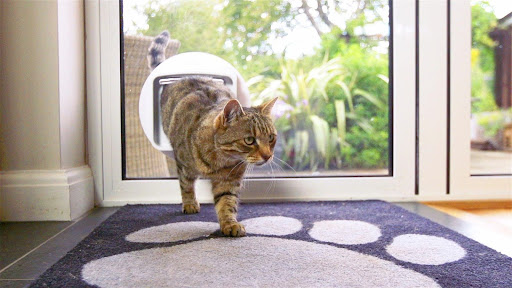Installing a cat flap can be a practical solution for cat owners, giving your feline friends the freedom to come and go as they please. However, the process can be more complex, and making mistakes can lead to various issues, from poor functionality to security concerns. This guide will walk you through the common mistakes to avoid during cat flap installation, ensuring a seamless experience for both you and your pet. For those who prefer professional assistance, cat flap installation services are always available to guarantee a perfect setup.
Choosing the Wrong Location
One of the most critical steps in installing a cat flap is selecting the correct location. Here are some common mistakes to avoid:
- Ignoring Security Concerns
Many pet owners overlook the security implications of where they place the cat flap. Installing it too close to a door lock or handle can give intruders an easy access point. Always ensure the cat flap is positioned in a place that doesn’t compromise your home’s security.
- Inaccessible Locations for Cats
Another common mistake is choosing a location that is difficult for your cat to reach. High or obstructed placements can deter your cat from using the flap. Make sure the chosen spot is easily accessible from both inside and outside.
- Exposure to Elements
Installing the cat flap in an area exposed to strong winds, rain, or direct sunlight can cause discomfort for your cat and potentially damage the flap. Choose a sheltered spot to protect your installation from the elements.
Incorrect Measurements and Cutting
Precise measurements and careful cutting are crucial for a functional cat flap. Here are common pitfalls:
- Inaccurate Measurements
Taking incorrect measurements can lead to a cat flap that doesn’t fit properly, causing drafts or even requiring reinstallation. Always double-check your measurements before cutting.
- Not Using the Right Tools
Using inappropriate or dull tools can result in uneven or jagged cuts, which look unsightly and affect the flap’s functionality. Invest in the correct tools or consider hiring cat flap installation services for a professional job.
- Failing to Follow Manufacturer Instructions
Each cat flap model may have specific installation instructions. Ignoring these guidelines can lead to improper installation. Always read and follow the manufacturer’s instructions carefully.
Neglecting Insulation and Weatherproofing
Proper insulation and weatherproofing are essential for maintaining energy efficiency and comfort. Common mistakes include:
- Skipping Sealant Application
Failing to apply a sealant around the cat flap can lead to drafts and water leaks. Ensure you use an appropriate sealant to create a weatherproof seal.
- Using Inferior Materials
Opting for cheap or unsuitable materials can compromise the cat flap’s insulation. To maintain the integrity of your installation, use high-quality materials recommended by the manufacturer.
- Overlooking Seasonal Adjustments
Seasonal changes can affect the performance of your cat flap. For instance, winter insulation may be needed to prevent heat loss. Regularly inspect and adjust your cat flap as required.
Ignoring Training and Adaptation
Once the cat flap is installed, it is essential to ensure your cat is comfortable using it. Mistakes in this area include:
- Not Training Your Cat
Assuming your cat will instinctively use the flap can lead to frustration. Spend time training your cat, using treats and positive reinforcement to encourage them to use the new entry point.
- Overwhelming Your Cat
Introducing the cat flap too suddenly or without gradual exposure can scare your cat. Provide a secure and stress-free environment and permit your companion to investigate the flap at leisure.
- Ignoring Behavioral Signs
If your cat shows reluctance or fear, don’t force them to use the flap. Pay attention to their behaviour and be patient, offering support and encouragement as needed.
Neglecting Maintenance and Upkeep
After installing a cat flap, ongoing maintenance is essential to ensure its longevity and functionality. Common mistakes include:
- Forgetting Regular Cleaning
Over time, cat flaps can accumulate dirt, debris, and even pet hair, hindering their operation. Regularly clean the flap’s interior and exterior to prevent blockages and ensure smooth operation.
- Ignoring Wear and Tear
Cat flaps can experience wear and tear with regular use, like any mechanical device. Inspect the flap periodically for signs of damage, such as cracks, loose hinges, or worn seals. Promptly addressing these issues can prevent the emergence of more substantial problems in the future.
- Not Lubricating Moving Parts
Lubricate the moving parts of the cat flap as the manufacturer recommends to maintain smooth operation. It includes hinges and locking mechanisms. Proper lubrication reduces friction and prolongs the flap’s life.
- Overlooking Security Checks
Periodically check the security features of the cat flap, such as locks and access control settings, to ensure they are functioning correctly and prevent unauthorised entry into your home.
Final Thoughts
Installing a cat flap can significantly enhance the quality of life for both you and your feline friend, providing them with the freedom they crave. However, avoiding common mistakes is crucial to ensuring a smooth and successful installation. Each step plays a vital role in choosing the right location and taking accurate measurements to ensure proper insulation and training for your cat. If you’re unsure or want to guarantee a flawless setup, consider utilising professional cat flap installation services. Following these guidelines, you can create a safe, secure, and functional entryway for your cat, enhancing their independence and peace of mind.

